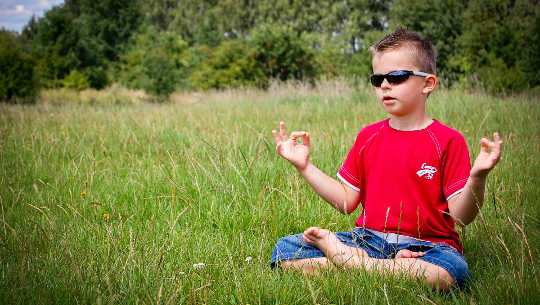
Image by Michal Jarmoluk
Meditating sounds easy. Sitting. Breathing. Focusing in a relaxed kind of way. So why isn't everyone doing it? For that matter why do so many who start meditating, or open a book on the subject, fail to carry through and make meditation a part of their daily lives?
The answer is that both our inner and outer worlds raise barriers between us and meditation. The greatest of these are the doubts about meditation raised by our own minds and by Western society. There are also certain spiritual/ psychological pitfalls that meditators can fall prey to if they fail to pay attention to their practice.
Without guidance, these barriers can seem insurmountable. But, with the aid of a little guidance, they can easily be bridged. As meditation teacher Ram Dass says in Journey of Awakening, "There are certain guidelines -- some from great masters and others from psychologists and other outside observers -- that can help you hone your intelligence and keep your balance."
DOUBT
You have had your first experiences of meditation, and they produced positive results in the way of relaxation, revitalization, and spiritual deepening. But you still find yourself resisting the idea of regular meditation practice. This almost unconscious reluctance to meditate is natural.
Our minds and deepest selves always resist change in some way, whether it's a move to a new town, a new social circle, or a new job. As Ram Dass warns, "One of the ego's favorite paths of resistance is to fill you with doubt." This resistance usually takes the form of fears or anxiety that undermine our commitment to meditation.
You have probably experienced doubts of your own. On the list below, check off any that have haunted you.
___Meditation is too easy or too hard.
___Meditation is a religion and will conflict with yours.
___Meditation means giving up things you like.
___Meditation is like being hypnotized.
___Meditation is a way of escaping reality.
___Meditation means shutting out the world.
___Meditation means you have to go to a monastery.
___Meditation is weird.
___Meditation means you need a teacher.
___Meditation has a right way and wrong way.
Why We Fear Meditation
The doubts and fears that plague us are often the echoes of misconceptions we learned at society's knee as we grew up. These negative myths, widely prevalent in the Americas and Europe, are the spawn of cultural ignorance, prejudicial misconceptions generated by rational, left-brain Western society's antithetical attitude toward anything Eastern, intuitive, and right-brain.
They are, doubtless, the very concerns that plague you when you think about meditating. Do you find yourself thinking meditation will be too hard or that it is a religion (and therefore in conflict with yours) or is it a kind of hypnosis? If so, the best anodyne is the truth. As it says in the Bible, "The truth shall make you free."
BANISHING DOUBTS
Don't resist these concerns. Our egos are healthy enough and strong enough to protect us from any of the supposed negative effects of meditation. Resisting these doubts means giving them power over you. They will seize control and bring your meditation to a halt. Instead, Ram Dass suggests an approach that has inspired the following exercise:
1 . Sit someplace free of distraction.
2. Focus on any doubts or worries you might have about meditation.
3. Be completely open to them, do not censor any out. Examine each carefully -- the absurdity of most will suggest itself instantly.
4. Consciously let go of each -- imagine it as a balloon that sails away and then vanishes out of sight.
ELEVEN MISCONCEPTIONS
The best bridge across these barriers to meditation is replacing ignorance and misconception with knowledge and fact.
1. Meditation is either too easy or too hard.
Meditation is simpler than you think. And, paradoxically, harder than you might think. The directions on how to meditate are deceptively simple. For instance, what could be clearer than instructions that merely direct you to watch your breath?
Try it for yourself. Right now. Close your eyes. And for the next inhalation and exhalation, just observe your breath. That's all.
If you were able to take one full breath, and not think, daydream, fidget, wonder what the heck you were doing, you have done incredibly well. If you are like the rest of us, however, you probably had a lot going on in that breath. It's amazing how many thoughts you can pack into just one breath when you take the time to actually examine the process of your mind.
Although the directions may be simple, what your mind does while you try to follow those directions is an entirely different thing.
Focusing on your breath or any object of meditation requires persistence and commitment. And it requires the kind of patience a parent has for a constantly straying six-year-old child at the zoo.
When you stray from the object of meditation and find yourself waking up, as you do on the highway, ten miles down the road, clueless as to how you got there, you simply return to the object of meditation. This is what meditation practice is: gently returning, without judgment, over and over again to the object of your meditation.
The key to successful meditation practice is, in the words of the famous violinist who was asked by a stranger how to get to Carnegie Hall, "practice, practice, practice."
2. Meditation is a religion.
You can practice any religion or no religion, and still derive the full benefits of meditation. You may also meditate using the techniques of your tradition. Meditation is an equal opportunity practice; it treats religion just as it treats everything else: openly and with total acceptance.
3. I'll have to give up the things I like.
You don't have to give up anything. There are no edicts against coffee, chocolate, Haagen-Dazs, World Professional Wrestling, MTV, or even Beavis and Butthead.
Of course, you may naturally find yourself cutting down on things that might not be in your own best interest. If you find yourself on your meditation cushion instead of watching a Seinfeld rerun or a football game, you'll know that meditation is putting that deeper part of you in contact with what is best for you.
4. It's like being asleep or hypnotized.
Meditation is about being awake, not asleep or in a trance state. And while relaxation is a naturally occurring phenomenon of meditation, it is not the object or goal of the practice. Think of it as a wonderful by-product, or perk, like a corner office or enclosed parking.
While in meditation, you may experience states that are even more relaxing than sleep or hypnotic trance. If this happens, bring your full attention to them, watch them, then let them go. You don't chase states of mind in meditation; rather, you welcome whatever comes your way, and then let it go.
5. Meditators are trying to escape from reality and responsibilities.
Some hold that meditation is a selfish, narcissistic attempt to avoid responsibilities and real life. Nothing is further from the truth. The goal of meditation is to become happier by developing the ability to escape into, not away from, life. When your mind is sharp and focused, your quality of life is improved, your experience of life is richer, and you are just naturally happier.
6. You have to shut out the world.
Meditation is about total immersion in the experience of the present moment, both internally and externally. There is a popular misconception that meditation can only be properly done in absolute silence, preferably on top of a mountain in Nepal, where the meditator is entirely removed from the sights and sounds of the material world. The skillful meditator takes his world as he finds it, without sunglasses, earplugs, or nose clips. In the real world, car alarms screech, children laugh and play, planes drone overhead, telephones suddenly ring, and neighbors play U-2 albums too loudly. When you meditate, you cultivate your innate ability to deal skillfully with all arising phenomena, whatever they may be.
Meditation is not about shutting out the world. It's about letting it in.
7. You have to go to a monastery.
Entering the monastic life isn't necessary to get the benefits of meditation. Josh B., a former Zen monk, now a record company executive with a hot new label, says, "The zendo is everywhere." (Zendo is the Zen word for meditation hall.)
In the Zen tradition there is a saying: "If you want a small enlightenment go to the country. If you want a big enlightenment, go to the city." This means that the more challenging the environment, the more it has to teach you. This may make New York City the world's best meditation hall.
The eighth-century Tibetan, Shantideva, wrote that a spiritual life could be lived anywhere. He says the following in his classic text, A Guide to the Bodhisattva Way of Life, (a bodhisattva is a person who aspires to attain full enlightenment for the benefit of all beings):
Where would I possibly find enough leather
With which to cover the surface of the earth? But wearing leather on the soles of my shoes
Is equivalent to covering the earth with it.
Make your world your monastery. And that includes your home, office, car, the subway, even the laundromat. Wherever you are, whatever you encounter is meant to provide you with exactly what you need to work with right now.
8. Meditation is weird.
Meditation is not only not weird, it's totally in keeping with the American way of life.
Our Declaration of Independence states that we have certain inalienable rights, including "life, liberty, and the pursuit of happiness." Those three rights are also the goals of meditation -- to be totally present in life, to be liberated from our confined sense of self, and to be happy. Meditation is not only not weird, it's downright patriotic.
9. You need a teacher.
Learning a skill is always easier when you have a good teacher. In the United States there is a scarcity of good, reputable meditation teachers. And the large followings of a few good teachers consequently make it difficult to receive training on an individual basis.
But that should not deter you. An old Buddhist proverb says, "When the student is ready, the teacher appears." It's been happening that way for thousands of years.
For now, this book (The Best Guide to Meditation) is more than adequate to get you started on the path of meditation. And don't worry, when you really need your teacher, he or she will appear.
10. There's a right way and a wrong way.
There is no one way and no best way to meditate. The ways of meditation are many, and stem from the world's rich and varied religious traditions. It is said that the Buddha alone taught eighty-four ways of mindfulness. So there's obviously room for many opinions.
Some schools and teachers of meditation insist that their way is the only correct way or system to meditate. Be skeptical of those who tell you, "It's my way or the highway." True teachers of meditation follow the middle way (a balance between a search for and a surrender to the truth). They are usually tolerant of and receptive to techniques from other disciplines.
If there is any right way to meditate, it will be the one that resonates with you, the one to which you want to apply yourself with discipline and diligence.
11. Meditation cuts you off from the rest of life.
Meditation is not just something you do on a cushion or in a chair for a certain amount of time and then forget about. Your goal should be to make meditation an ongoing part of your life.
Dr. Andrew Weil, the well-known author on holistic health, says, on his CD, Eight Meditations for Optimum Health, "On some level, you are meditating all the time. Become aware of that practice, extending this awareness to more and more areas of your daily life."
It's good advice. Try it for yourself. Stay as mindful as possible, all day long.
Reprinted with permission of the publisher,
Renaissance Books, Los Angeles, CA.
©1998. www.renaissancebks.com
Article Source
The Best Guide to Meditation
by Victor N. Davich.
You've heard about meditation but don't know where to begin? Begin with this book! Want instant gratification? Go directly to chapter 2 and you will start meditating immediately! Your doctor says you can control stress with meditation. Your doctor is right! It also works on anxiety and hypertension. This book jump-starts the novice by making meditation instantly accessible, and shows intermediate and advance meditators how to deepen their practice.
Busy, busy, busy? If you're looking for peace of mind, happiness, relaxation, and serenity, try meditation. It's simple, it's natural, and its results can be permanent
Feeling muddleheaded, slightly out of it? Meditating gets you in touch with your emotions and teaches you how to go with the flow.
Info/Order this book.
About the Author
Victor N. Davich has studied for more than twenty-five years with several of the West's foremost meditation teachers. He has also been a business affairs attorney, creative consultant, and producer for Paramount Pictures, Fox Broadcasting, and Universal-TV. Victor brings a unique combination to teaching meditation and stress reduction: an attorney for Fortune 500 companies, he is also an authority on meditation and author of popular meditation books. Time Magazine calls his new, unique, and innovative 8 Minute Meditation system "The most American form of meditation yet."

























